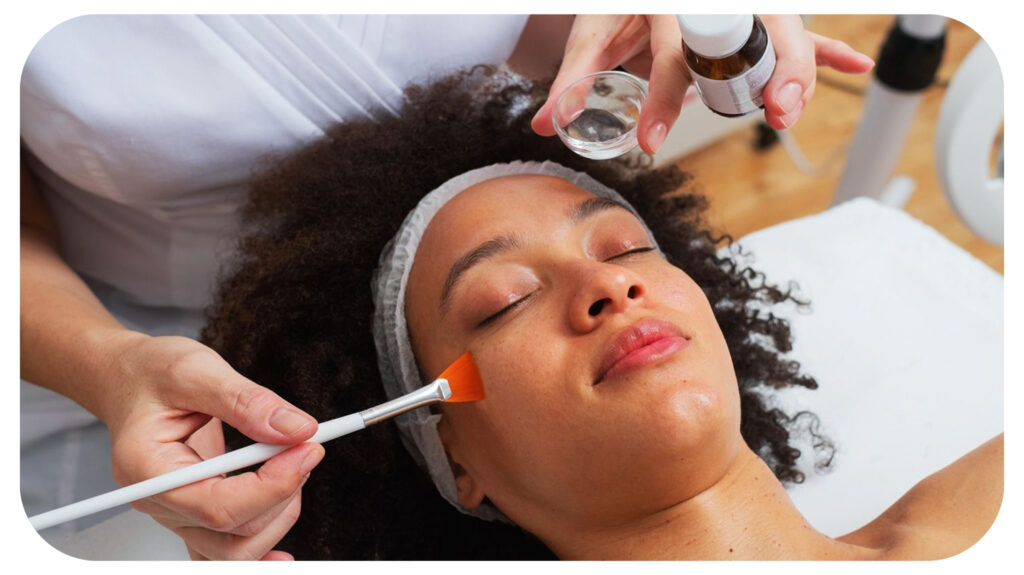Understanding Chemical Peels: Benefits, Risks, and Procedure

Hello, skincare enthusiasts! As we all know, many of us prioritize having healthy, radiant skin. In recent years, chemical peels have become a popular and effective method of glowing complexion.
If you’re interested in this treatment but need help knowing where to start, welcome. In this article, we’ll look at the benefits, risks, and procedure for chemical peels. We’ll go over everything from what they are and how they work to the various types of peels, their benefits, and any potential risks or side effects.
By the end of this article, you will have a thorough understanding of this exciting skincare treatment and be able to determine whether it is right for you. So sit back, relax, and prepare to dive in!
Contents
ToggleWhat are chemical peels?
Chemical peels are a popular skincare treatment that involves applying a chemical solution to the skin, causing the outer layers to peel off. This procedure eliminates dead cells while stimulating the growth and development of new, healthy skin cells, summarizing a brighter, smoother, and more even complexion.
There are three chemical peels: superficial, medium, and deep. The recommended peel will be based on the individual’s skin type, concerns, and desired results.
To better understand the science of such peels, we spoke with skincare expert Dr Jane Smith. Dr Smith explains that chemical peels exfoliate the skin and remove the outermost layers of old skin layers. This improves the appearance of fine lines, wrinkles, and hyperpigmentation while also stimulating collagen production for firmer, more youthful-looking skin.
Benefits of Chemical Peels
Chemical peels provide various benefits to those looking to improve the appearance and texture of their skin. One primary advantage of renewing peels is their ability to treat a wide range of skin issues, like fine line, acne and wrinkles, excessive pigmentation, acne scars, and uneven skin tone.
Chemical peels can also stimulate collagen production inside the human, thereby improving skin texture and firmness. Furthermore, they can improve the overall skin health and radiance making it appear brighter and more youthful.
It’s important to understand that the results regarding chemical peelings are brief. It may take several treatments to achieve the desired results, and a proper skincare regimen at home is required to maintain the treatment’s effects. Chemic peels, on the other hand, can provide significant long-term benefits that make the investment worthwhile.
Risks and Side Effects
While chemical peels can provide numerous benefits, they also carry some risks and side effects. The most common side effects are redness, skin irritation, and sensitivity. These side effects are usually mild and resolve within a few days of treatment.
Scarring, infection, and changes in skin pigmentation are among the more serious side effects that can occur. Although these side effects are uncommon, discussing them with a skincare professional before undergoing a chemical peel is critical. The risk of the infection and spoiled impressions increases if you visit the unqualified dermatologist.
It’s also worth noting that only some are ideal candidates for chemical peels. People with certain skin conditions, eczema or rosacea, may not be good candidates for this procedure. Pregnant women and those with a history of cold sores should also avoid chemical peels. It is critical to consult with a skincare professional to determine whether a chemical peel is suitable.
Chemical Peel Procedure
If you’ve decided the chemical peel fits for you, you should know what to expect from the procedure. The first step is to schedule a consultation with a skincare expert, such as at AcneClinicNYC . The skincare professional will assess your skin type and concerns during this consultation to determine the best peel.
During the procedure, the chemical solution is applied to the skin and left on for a set period. The time required will vary depending on the peel used and the individual’s skin type. For several days after the solution is removed, the skin may appear red, swollen, or flaky.
Follow the derma care professional’s post-treatment instructions, including avoiding sun exposure and using gentle skincare products. With proper care, synthetic peels can provide significant long-term benefits.
Conclusion:
Finally, chemical peels are a popular and effective way to brighten, smooth, and even out your skin tone. They provide numerous advantages, including better skin texture, fewer fine lines and wrinkles, and fewer acne scars. However, it is critical to understand chemical peels’ risks and side effects before consulting with a skin care professional to determine whether this treatment is right for you.
If you want to learn more about the benefits of chemical peels, schedule a consultation with a skincare professional like those at AcneClinicNYC. A chemical peel can be a great investment in the health and appearance of your tegument if done correctly and with care.
Recommended For You
What Sets a Hair Waver Apart from Other Comparable Hair Styling Tools
Most Inside
Most Inside offers high-quality recommendations and valuable updates to enhance all aspects of your life, providing premium guidance and enriching experiences.




